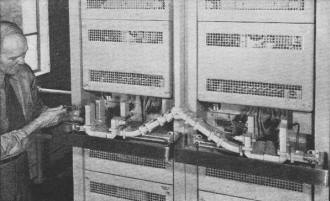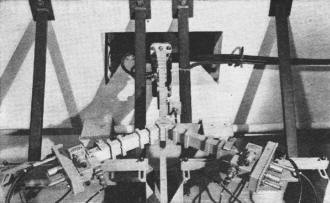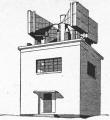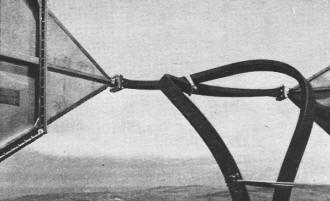|
I have always been a stickler
for creating neat, orderly arrangements when building any type of circuit assembly.
Many moons ago when starting out as an electrician, I made a point of installing
straight runs of
Romex type cable with no twists, evenly
spaced staples, and keeping the identification marking to the outside. Conduit was
precisely bent and installed, again with organized parallel runs and even spacing
where possible (all while conforming to the
NEC). Circuit breaker panel wiring looked like something seen
in an Apollo space capsule (ok, I exaggerated a bit here). Electrical inspectors
often complimented my work. Moving on to an electronics career, the habits carried
over when prototyping and even when directing layout for production PCBs or chassis
assemblies, including cabling. The greatest enjoyment I had was when laying out
runs of waveguide. Standardized manufactured straight and corner bends, along with
integral components like switches, couplers, circulators, etc., to some extent guaranteed
a nice-looking configuration, but a thoughtful planning guaranteed an impressive
result. Rectangular waveguide always looks more high-tech IMHO since circular waveguide
can look like coaxial cable (if you overlook the bolted flanges). This advertisement
by Bell Telephone Labs highlights waveguide circuits used in their relatively new
(in 1948) microwave long distance relay distribution system. For a company that
really had no domestic competition at the time, Bell Labs put a lot of effort into
promoting their work.
Bell Telephone Laboratories Ad: Pipe Circuits

1 - Base of a waveguide circuit in a repeater station of the
New York-Boston radio relay system.

2 - The waveguide continues upward through the roof of the station
toward the antennas.

Complete repeater station.
Unlike radio broadcast waves, microwaves are too short to be handled effectively
in wire circuits. So, for carrying microwaves to and from antennas, Bell Laboratories
scientists have developed circuits in "pipes," or waveguides.
Although the waves travel in the space within the waveguides, still they are
influenced by those characteristics which are common to wire circuits, such as capacitance
and inductance. A screw through the guide wall acts like a capacitor; a rod across
the inside, like an inductance coil. Thus transformers, wave filters, resonant circuits
- all have their counterpart in waveguide fittings. Such fittings, together with
the connection sections of waveguide, constitute a wave-guide circuit.
From Bell Laboratories research came the waveguide circuits which carry radio
waves between apparatus and antennas of the New York-Boston radio relay system.
As in long distance wire communication, the aim is to transmit wide frequency bands
with high efficiency - band widths which some day can be expanded to carry thousands
of telephone conversations and many television pictures.
Practical aspects of waveguides were demonstrated by Bell Telephone Laboratories
back in 1932. Steady exploration in new fields, years ahead of commercial use, continues
to keep your telephone system the most advanced in the world.

3 - The waveguide connects with antennas, which are
oriented in azimuth with antennas at next station.
Bell Telephone Laboratories
Exploring and Inventing, Devising and Perfecting for Continued Improvements and
Economies in Telephone Service

Posted November 27, 2019
(updated from original post on 12/10/2015)
| Bell Telephone
Laboratories Infomercials |
-
The Future Holds Great Promise
- August 1949 Popular Science
-
Waveguide: 7/47 Popular Mechanics
-
Wire Wrapping - 10/1953 Popular Science
-
X-Rays, 4/60 Radio-electronics
- The Battle of
the Atoms, 4/1948 Radio News
-
The Transistor, 6/1952 Radio-Electronics
- 90-Mile Laboratory
for Telephone and Television, 6/1945 Radio News
-
Wire-Wrap, 10/53 Radio-Electronics
-
EDT Crystals, 10/47 Radio-Craft
- Germanium Refining,
5/54 Radio & TV News
- Crystal Timekeeping,
1/46 Radio News
- Transatlantic
Cable, 11/56 Radio & Television News
- Pipe Circuits,
11/48 Radio & Television News
-
Coaxial
Electron Tube, 6/54 Radio & Television News
- Thermocompression
Wire Bonding, 3/58 Radio News
-
Radio Relay Stations, 8/52 Radio & Television News
- Isolators,
6/56 Radio & Television News
- Punch
Cards, 3/55 Radio & Television News
-
Over-the-Horizon
Communications, 10/55 Radio & Television News
- Memory
Devices, 2/58 Radio & TV News
-
Adventure in Silicon, 5/55 Radio & Television News
- Pipes of Progress,
6/55 Radio & Television News
-
Project Echo, 11/60 Electronics World
|
-
Testing Phones - November 1947 Popular Science
-
Jacques Bernoulli, February 1960 Radio-Electronics
-
Type-O Carrier System, October 1952 Radio-Electronics
-
Electron Microscope, 4/1952 Radio-Electronics
-
Thermistor, 11/1946 Radio-Craft
-
Germanium Crystal, 1/1954 Radio-Electronics
-
Lens
Antenna, 5/46 Radio-Craft
- Quality Control, 6/46
Radio News Article
- Transcontinental
Radio-Relay, 10/51 Radio & TV News
- Solar
Battery, 7/54 Radio & Television News
-
Germanium Transistors, 1/54 Radio & Television News
- Cavity
Magnetron, 10/45 Radio News
-
The Cableman, 10/49 Radio & Television News
-
Coaxial Cable, 12/49 Radio & Television News
-
Tin
Whiskers, 12/55 Radio & Television News
- Relay
Contact Inspection, 7/55 Radio & Television News
- Transistor's
10th Anniversary, 6/58 Radio & Television News
-
Wire
Wrapping, 10/53 Radio & Television News
- Junction
Diode Amplifier, 11/58 Radio News
-
Nobel Prize Winners, 2/57 Radio & Television News
-
Diode Speeds Voices, 8/58 Popular Electronics
-
Microwave Relays, 7/59 Electronics World
|
|















